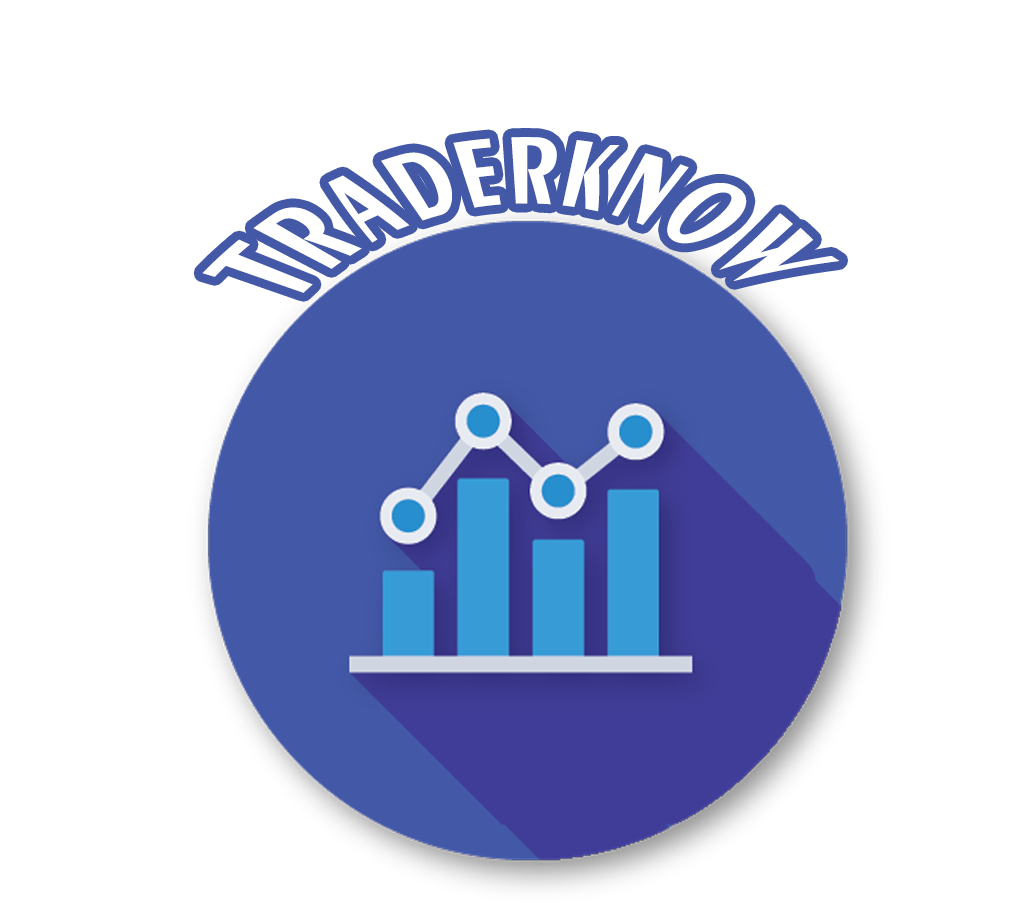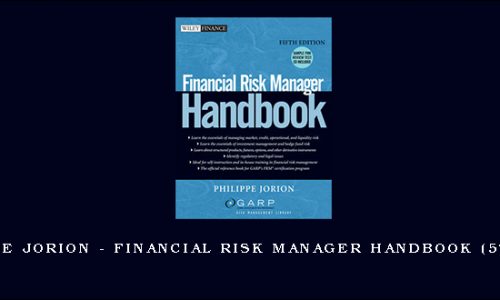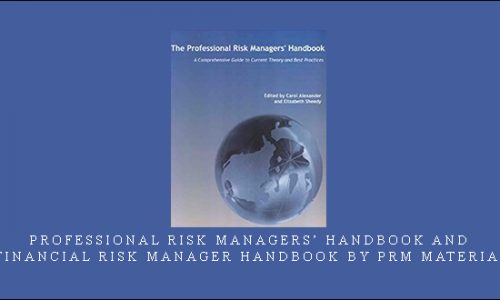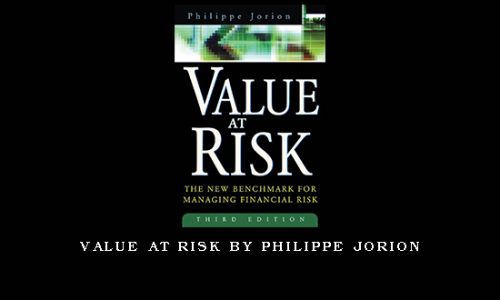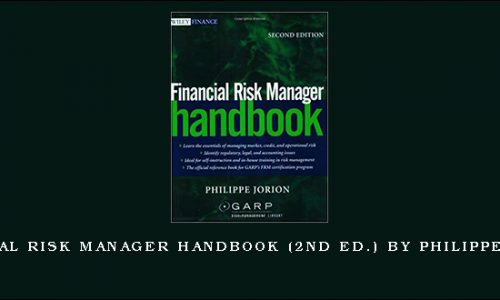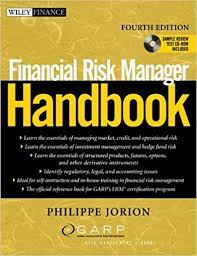 Financial Risk Manager Handbook (4th Ed.) by Philippe Jorion
Financial Risk Manager Handbook (4th Ed.) by Philippe Jorion
Description
An essential guide to financial risk management and the only way to get a great overview of the subjects covered in the GARP FRM Exam
The Financial Risk Management Exam (FRM Exam) is given by the Global Association of Risk Professionals (GARP) annually in November for risk professionals who want to earn FRM(r) certification. The Financial Risk Manager Handbook, Fourth Edition is the definitive guide for those preparing to take the FRM Exam as well as a valued working reference for risk professionals. Written with the full support of GARP, and containing questions and solutions from previous exams, this book is a valuable resource for professionals responsible for or associated with financial risk management.
Table of Contents
Preface.
Introduction.
PART ONE: Quantitative Analysis.
Chapter 1: Bond Fundamentals.
1.1 Discounting, Present, and Future Value.
1.2 Price-Yield Relationship.
1.3 Bond Price Derivatives.
1.4 Important Formulas.
1.5 Answers to Chapter Examples.
Appendix: Applications of Infinite Series.
Chapter 2: Fundamentals of Probability.
2.1 Characterizing Random Variables.
2.2 Multivariate Distribution Functions.
2.3 Functions of Random Variables.
2.4 Important Distribution Functions.
2.5 Limit Distributions.
2.6 Important Formulas.
2.7 Answers to Chapter Examples.
Appendix: Review of Matrix Multiplication.
Chapter 3: Fundamentals of Statistics.
3.1 Real Data.
3.2 Parameter Estimation.
3.3 Regression Analysis.
3.4 Important Formulas.
3.5 Answers to Chapter Examples.
Chapter 4: Monte Carlo Methods.
4.1 Simulations with One Random Variable.
4.2 Implementing Simulations.
4.3 Multiple Sources of Risk.
4.4 Important Formulas.
4.5 Answers to Chapter Examples.
Also Get Financial Risk Manager Handbook (4th Ed.) by Philippe Jorion on Traderknow.com
PART TWO: Capital Markets.
Chapter 5: Introduction to Derivatives.
5.1 Overview of Derivatives Markets.
5.2 Forward Contracts.
5.3 Futures Contracts.
5.4 Swap Contracts.
5.5 Important Formulas.
5.6 Answers to Chapter Examples.
Chapter 6: Options.
6.1 Option Payoffs.
6.2 Option Premiums.
6.3 Valuing Options.
6.4 Other Option Contracts.
6.5 Valuing Options by Numerical Methods.
6.6 Important Formulas.
6.7 Answers to Chapter Examples.
Chapter 7: Fixed-Income Securities.
7.1 Overview of Debt Markets.
7.2 Fixed-Income Securities.
7.3 Analysis of Fixed-Income Securities.
7.4 Spot and Forward Rates.
7.5 Prepayment.
7.6 Securitization.
7.7 Important Formulas.
7.8 Answers to Chapter Examples.
Chapter 8: Fixed-Income Derivatives.
8.1 Forward Contracts.
8.2 Futures.
8.3 Swaps.
8.4 Options.
8.5 Important Formulas.
8.6 Answers to Chapter Examples.
Chapter 9: Equity, Currency, and Commodity Markets.
9.1 Equities.
9.2 Convertible Bonds and Warrants.
9.3 Equity Derivatives.
9.4 Currency Markets.
9.5 Currency Swaps.
9.6 Commodities.
9.7 Important Formulas.
9.8 Answers to Chapter Examples.
Also Get Financial Risk Manager Handbook (4th Ed.) by Philippe Jorion on Traderknow.com
PART THREE: Market Risk Management.
CHAPTER 10: Introduction to Market Risk Measurement.
10.1 Introduction to Financial Market Risks.
10.2 VAR as a Downside Risk Measure.
10.3 VAR Parameters.
10.4 Elements of VAR Systems.
10.5 Stress-Testing.
10.6 Liquidity Risk.
10.7 Important Formulas.
10.8 Answers to Chapter Examples.
Appendix: Desirable Properties for Risk Measures.
CHAPTER 11: Sources of Market Risk.
11.1 Sources of Loss: A Decomposition.
11.2 Currency Risk.
11.3 Fixed-Income Risk.
11.4 Equity Risk.
11.5 Commodity Risk.
11.6 Risk Simplification.
11.7 Important Formulas.
11.8 Answers to Chapter Examples.
Appendix: Simplification of the Covariance Matrix.
Also Get Financial Risk Manager Handbook (4th Ed.) by Philippe Jorion on Traderknow.com
CHAPTER 12: Hedging Linear Risk.
12.1 Introduction to Futures Hedging.
12.2 Optimal Hedging.
12.3 Applications of Optimal Hedging.
12.4 Important Formulas.
12.5 Answers to Chapter Examples.
CHAPTER 13: Nonlinear Risk: Options.
13.1 Evaluating Options.
13.2 Option “Greeks”.
13.3 Dynamic Hedging.
13.4 Important Formulas.
13.5 Answers to Chapter Examples.
CHAPTER 14: Modeling Risk Factors.
14.1 Normal and Lognormal Distributions.
14.2 Fat Tails.
14.3 Time-Variation in Risk.
14.4 Important Formulas.
14.5 Answers to Chapter Examples.
CHAPTER 15: VAR Methods.
15.1 VAR: Local versus Full Valuation.
15.2 VAR Methods: Overview.
15.3 Example.
15.4 Important Formulas.
15.5 Answers to Chapter Examples.
PART FOUR: Investment Risk Management.
Also Get Financial Risk Manager Handbook (4th Ed.) by Philippe Jorion on Traderknow.com
CHAPTER 16: Portfolio Management.
16.1 Institutional Investors.
16.2 Portfolio Management.
16.3 Risk Budgeting.
16.4 Important Formulas.
16.5 Answers to Chapter Examples.
CHAPTER 17: Hedge Fund Risk Management.
17.1 The Hedge Fund Industry.
17.2 Leverage, Long, and Short Positions.
17.2.3 Long and Short Positions.
17.3 Hedge Fund Risk Management.
17.4 Hedge Fund Transparency.
17.5 Important Formulas.
17.6 Answers to Chapter Examples.
PART FIVE: Credit Risk Management.
CHAPTER 18: Introduction to Credit Risk.
18.1 Settlement Risk.
18.2 Overview of Credit Risk.
18.3 Measuring Credit Risk.
18.4 Credit Risk Diversification.
18.5 Important Formulas.
18.6 Answers to Chapter Examples.
Also Get Financial Risk Manager Handbook (4th Ed.) by Philippe Jorion on Traderknow.com
CHAPTER 19: Measuring Actuarial Default Risk.
19.1 Credit Event.
19.2 Default Rates.
19.3 Recovery Rates.
19.4 Assessing Corporate and Sovereign Rating.
19.5 Important Formulas.
19.6 Answers to Chapter Examples.
CHAPTER 20: Measuring Default Risk from Market Prices.
20.1 Corporate Bond Prices.
20.2 Equity Prices.
20.3 Important Formulas.
20.4 Answers to Chapter Examples.
Also Get Financial Risk Manager Handbook (4th Ed.) by Philippe Jorion on Traderknow.com
CHAPTER 21: Credit Exposure.
21.1 Credit Exposure by Instrument.
21.2 Distribution of Credit Exposure.
21.3 Exposure Modifiers.
21.4 Credit Risk Modifiers.
21.5 Important Formulas.
21.6 Answers to Chapter Examples.
CHAPTER 22: Credit Derivatives and Structured Products.
22.1 Introduction.
22.2 Types of Credit Derivatives.
22.3 Pricing and Hedging Credit Derivatives.
22.4 Structured Products.
22.5 CDO Market.
22.6 Conclusions.
22.7 Important Formulas.
22.8 Answers to Chapter Examples.
CHAPTER 23: Managing Credit Risk.
23.1 Measuring the Distribution of Credit Losses.
23.2 Measuring Expected Credit Loss.
23.3 Measuring Credit VAR.
23.4 Portfolio Credit Risk Models.
23.5 Important Formulas.
23.6 Answers to Chapter Examples.
Also Get Financial Risk Manager Handbook (4th Ed.) by Philippe Jorion on Traderknow.com
PART SIX: Operational and Integrated Risk Management.
CHAPTER 24: Operational Risk.
24.1 The Importance of Operational Risk.
24.2 Identifying Operational Risk.
24.3 Assessing Operational Risk.
24.4 Managing Operational Risk.
24.5 Answers to Chapter Examples.
Appendix: Causal Networks.
CHAPTER 25: Risk Capital and RAROC.
25.1 RAROC.
25.2 Performance Evaluation and Pricing.
25.3 Important Formulas.
25.4 Answers to Chapter Examples.
CHAPTER 26: Firm-Wide Risk Management.
26.1 Integrated Risk Management.
26.2 Best Practices Reports.
26.3 Organizational Structure.
26.4 Controlling Traders.
26.5 Answers to Chapter Examples.
Also Get Financial Risk Manager Handbook (4th Ed.) by Philippe Jorion on Traderknow.com
PART SEVEN: Legal, Accounting, and Tax Risk Management.
CHAPTER 27: Legal Issues.
27.1 Legal Risks with Derivatives.
27.2 Netting.
27.3 ISDA Master Netting Agreement.
27.4 The 2002 Sarbanes-Oxley Act.
27.5 Glossary.
27.6 Answers to Chapter Examples.
CHAPTER 28: Accounting and Tax Issues.
28.1 Internal Reporting.
28.2 Major Issues in Reporting.
28.3 External Reporting: FASB.
28.4 External Reporting: IASB.
28.4.1 IAS 39.
28.5 Tax Considerations.
28.6 Answers to Chapter Examples.
PART EIGHT: Regulation and Compliance.
Also Get Financial Risk Manager Handbook (4th Ed.) by Philippe Jorion on Traderknow.com
CHAPTER 29: Regulation of Financial Institutions.
29.1 Definition of Financial Institutions.
29.2 Systemic Risk.
29.3 Regulation of Commercial Banks.
29.4 Regulation of Securities Houses.
29.5 Tools and Objectives of Regulation.
29.6 Answers to Chapter Examples.
CHAPTER 30: The Basel Accord.
30.1 Steps in the Basel Accord.
30.2 The 1988 Basel Accord.
30.3 Illustration.
30.4 The New Basel Accord.
30.5 Conclusions.
30.6 Important Formulas.
30.7 Answers to Chapter Examples.
CHAPTER 31: The Basel Market Risk Charge.
31.1 The Standardized Method.
31.2 The Internal Models Approach.
31.3 Stress Testing.
31.4 Backtesting.
31.5 Important Formulas.
31.6 Answers to Chapter Examples.
About the CD-ROM.
Index.
Also Get Financial Risk Manager Handbook (4th Ed.) by Philippe Jorion on Traderknow.com
Author Information
Philippe Jorion is Professor of Finance at the Paul Merage School of Business at the University of California at Irvine. He holds an MBA and a PhD from the University of Chicago and a degree in engineering from the University of Brussels. Dr. Jorion has authored more than eighty publications—directed towards academics and practitioners—on the topic of risk management and international finance. He is on the editorial board of a number of financial journals and was editor of the Journal of Risk. He has won the Smith Breeden Prize for research, the William F. Sharpe Award for Scholarship in Financial Research, and the Graham and Dodd Scroll Award. He has written the first three editions of Financial Risk Manager Handbook (Wiley), as well as Financial Risk Management: Domestic and International Dimensions; Big Bets Gone Bad: Derivatives and Bankruptcy in Orange County; and Value at Risk: The New Benchmark for Managing Financial Risk.
Also Get Financial Risk Manager Handbook (4th Ed.) by Philippe Jorion on Traderknow.com
New to This Edition
- Provides support for candidates taking GARP’s FRM®exam, the globally accepted benchmark qualification for risk management practitioners.
- Provides the core knowledge for the FRM material in a systematic and consistent fashion, including questions from previous exams and solutions explained at the back of each chapter.
- Includes material on quantitative methods, capital markets, and market, credit, operational, and integrated risk management.New material on extreme value theory, new techniques in operational risk management, and corporate risk management.
- Outlines the essentials of financial risk managementin a manner ideal for use in university courses and in-house training programs.
Also Get Financial Risk Manager Handbook (4th Ed.) by Philippe Jorion on Traderknow.com
Visit more course: FINANCIAL DEVELOPMENT
The same course: M.Rusydi Marc Yor Rene M.Stulz Robert Cinnamon Srdjan Stojanovic Stephen G.Ryan Steve Dalton . Sumru Altug Suresh Sundaresan Thomas Fitch Tom Taulli Lidiya K Tom Taulli Peter Dunkart. Jo Dunning Brendon Burchard Bob Bly Alex Becker Alan Weiss Talmadge Harper
Available at traderknow.com
Please contact email: [email protected] If you have any question.
Course Features
- Lectures 0
- Quizzes 0
- Duration 50 hours
- Skill level All levels
- Language English
- Students 88
- Assessments Yes
